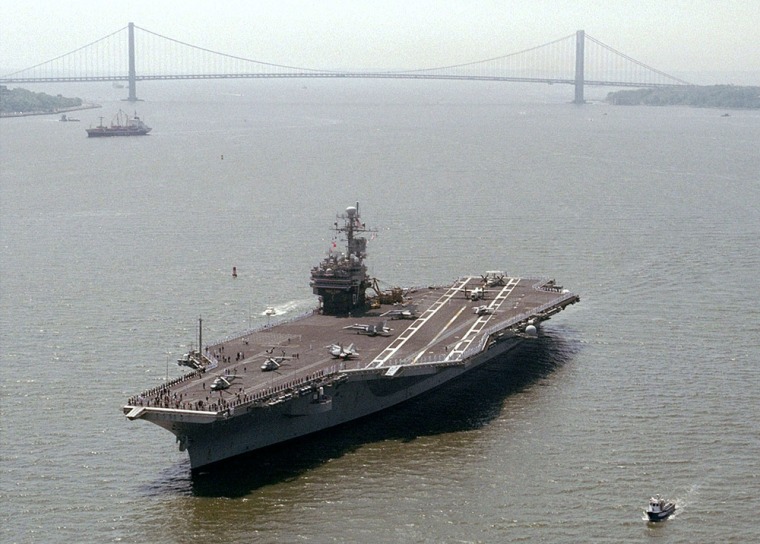Can a military force that is flexing every muscle and sinew in a global war against terrorism be restructured, redesigned and reformed at the same time? President Bush on Friday repeated his intention to make sure it is, promising graduating Naval Academy midshipmen that the United States will be able to meet any challenge in the 21st century.
The issue is not merely theoretical for the graduating Navy and Marine Corps officers in the audience. Of particular interest to them is the debate over the size of the American carrier fleet. Since World War II, the United States always has maintained between 12 and 15 large carriers, and over the years the number 12 became something of a minimum requirement.
The president's budget this year proposes to reduce the number of aircraft carriers in the fleet from 12 to 11 to save the Navy some $350 million. The carrier in question, the USS John F. Kennedy, a 41 year-old warship, was to have undergone a refit this year that was to keep it in service until 2018.
Balancing act
The carrier reduction is a classic case of the difficult decisions the president spoke of Friday, how "to fight the war on terror and transform our military at the same time." Already, members of Congress are lining up against the idea of reducing the carrier force, whether for strategic reasons or out of fear among the Florida delegation for the future of the ship's homeport at Mayport or the Virginia delegation who don't want to see layoffs at Hampton Roads, where the Kennedy's refit was to take place.
Several pieces of legislation have been introduced in the House and Senate to mandate a 12 carrier force since the Kennedy’s retirement was proposed after an internal review of Pentagon spending led by Deputy Defense Secretary Paul Wolfowitz last year.
"If you challenge the established forces, you'll face opposition," Bush said. "The champions of change are the ones who make history."
Several pieces of legislation have been introduced in the House and Senate to mandate a 12 carrier force since the proposed retirement, which came out of an internal review done by Deputy Defense Secretary Paul Wolfowitz last year, came to light. On May 6, the House passed a bill that would stall the retirement issue until next year at least, and the proposal is now being debated in the Senate.
A Congressional Research Service report on the issue notes, of all the proposals in the Wolfowitz plan, the retirement of the Kennedy "is the only adjustment ... that clearly called for a reduction in the operational force structure of a military service."
The costly weapons conundrum
The administration came to office promising to revisit such large and expensive weapons systems with an eye toward "skipping a generation" of weapons and building a military force that would maintain the American technological edge well into the century.
The military budget proposal before Congress -- some $441 billion for fiscal 2006 -- plus an estimated $85 billion more to fund operations in Iraq, Afghanistan and elsewhere, means the United States is now spending, as a percentage of GDP, more on its armed forces than at any time since the height of the Korean War in the early 1950s.
These priorities are reflected in the president's budget request. For instance, research and development funding remains at near record levels -- $69.4 billion. Unmanned aircraft, a new class of small, fast coastal navy vessels and space-based satellite weapons are among the "transformational" weapons being funded.
At the same time, over the past few years, major projects that fit into that rubric have fallen victim to the new priorities of the Bush administration, including the $38 billion Comanche helicopter and the $11 billion Crusader self-propelled artillery system for the Army; a $9 billion Navy missile defense system and other, smaller programs. Navy attack submarines, too, have been cut -- impacting bases that maintain and support them like those in Groton, Conn. and Portsmouth, N.H., both targeted for closure by the Pentagon's base closing commission this month.
Yet, transformation advocates say that what's needed is rethinking gigantic, established weapons programs like the Abrams main battle tank and the fleet aircraft carrier. But critics note that the "next generation" carrier, the CVN-21, is not a whole lot different in its capabilities than the John F. Kennedy.
"The administration is continuing to move ahead with the vast majority of major weapons platforms included in the plan inherited from the Clinton administration," military analyst Steven Koziak writes in a newly released report on military spending. "The latest defense budget request proposes to scale back a number of additional acquisition programs. However, most or all of these reductions involved stretching out or truncating the procurement of new weapons systems, rather than canceling new programs."
Controversy still swirls around the huge outlays being proposed for the space-based missile defense system, which has endured years of failed tests. The president has proposed spending about $9 billion on the Missile Defense Agency and its offshoots in 2006, a cut of about $1 billion from this year.
“We can transform our capabilities to defend our citizens and deliver justice to our enemies,” the president said. “To meet the threats of the 21st century, we are developing new technologies that will make our forces faster, lighter, more agile, and more lethal.”
